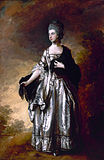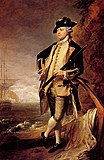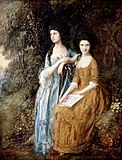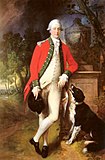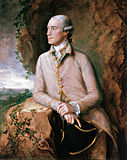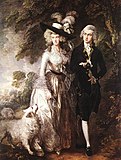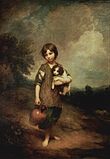Thomas Gainsborough: Difference between revisions
a point , clearly visible stokes |
→Technique: Added ref to Richard III DNA Tags: Mobile edit Mobile web edit |
||
| Line 66: | Line 66: | ||
Gainsborough's only known assistant was his nephew, [[Gainsborough Dupont]].<ref name=NGA/> In the last year of his life he collaborated with [[John Hoppner]] in painting a full length portrait of [[John Chetwynd-Talbot, 1st Earl Talbot|Lady Charlotte Talbot]]. |
Gainsborough's only known assistant was his nephew, [[Gainsborough Dupont]].<ref name=NGA/> In the last year of his life he collaborated with [[John Hoppner]] in painting a full length portrait of [[John Chetwynd-Talbot, 1st Earl Talbot|Lady Charlotte Talbot]]. |
||
In 2011, Gainsborough's portrait of ''Miss Read'' (Mrs |
In 2011, Gainsborough's portrait of ''Miss Read'' (Mrs Frances Villebois) was sold by [[Michael Pearson, 4th Viscount Cowdray]] for a record price of £6.5M.<ref>{{cite news|title=Why I'm swapping my £25m house for a cottage|url=http://www.dailymail.co.uk/news/article-2015843/As-Lord-Cowdray-holds-exceedingly-grand-car-boot-sale--Why-Im-swapping-25m-house-cottage.html#axzz2Jq0OMTUy|newspaper=Daily Mail | location=London|first=Robert|last=Hardman|date=17 July 2011}}</ref> She was a matrilineal descendant of [[Cecily Neville, Duchess of York]], and the [[mitochondrial DNA]] descent through which the remains of [[Richard III of England]] were [[Exhumation of Richard III of England|identified]] in 2013 passes through her and her daughter Harriet:<ref>http://www.le.ac.uk/richardiii/science/familytree.html</ref><ref name=Fig1>{{cite web|url=http://www.nature.com/ncomms/2014/141202/ncomms6631/fig_tab/ncomms6631_F1.html|title=Figure 1: Genealogical links between Richard III and modern-day relatives who participated in this study. |work=Nature Communications|author=Turi E. King ''et al.''|doi=10.1038/ncomms6631|date=2014|accessdate=December 2, 2014}}</ref> |
||
==In TV, fiction and music== |
==In TV, fiction and music== |
||
Revision as of 05:40, 3 December 2014
Thomas Gainsborough | |
|---|---|
 Self-portrait, (1759) | |
| Born | Thomas Gainsborough 14 May 1727 (baptised) |
| Died | 2 August 1788 (aged 61) London, England |
| Nationality | British |
| Known for | Painter |
| Notable work | Mr and Mrs Andrews The Blue Boy |
Thomas Gainsborough FRSA (christened 14 May 1727 – 2 August 1788) was an English portrait and landscape painter.
Biography
Gainsborough was the youngest son of John Gainsborough, a weaver in Suffolk. One of his brothers, John was known as Scheming Jack because of his passion for designing curiosities, another Humphrey, had a faculty for mechanics and was said to have invented the method of condensing steam in a separate vessel, which was of great service to James Watt.[1] Gainsborough left home in 1740 to study art in London with Hubert Gravelot, Francis Hayman, and William Hogarth. In 1746, he married Margaret Burr, and they became parents of two daughters. He moved to Bath in 1759 where fashionable society patronised him, and he began exhibiting in London. In 1769, he became a founding member of the Royal Academy, but his relationship with the organization was thorny and he sometimes withdrew his work from exhibition. Gainsborough moved to London in 1774, and painted portraits of the king and queen, but the king was obliged to name as royal painter Gainsborough's rival Joshua Reynolds. In his last years, Gainsborough painted relatively simple landscapes and is credited (with Richard Wilson) as the originator of the 18th century British landscape school. Gainsborough died of cancer in 1788 and was buried at St. Anne's Church, Kew.

He painted quickly, and his later pictures are characterised by a light palette and easy strokes. He preferred landscapes to portraits. William Jackson in his contemporary essays said of him 'to his intimate friends he was sincere honest and his heart was always alive to every feeling of honour and generosity but avoided the company of literary men, who were his aversion, but for a letter to an intimate friend he had few equals and no superior'.[2]
Career
Suffolk

Thomas Gainsborough was born in Sudbury, Suffolk, the youngest son of John Gainsborough, a weaver and maker of woollen goods, and his wife, the sister of the Reverend Humphry Burroughs.[3] He spent his childhood at what is now Gainsborough's House, on Gainsborough Street (he later resided there, following the death of his father in 1749).[citation needed] The original building still survives and is now a dedicated House to the his life and art. When he was still a boy he impressed his father with his drawing and painting skills and he was allowed to go to London to study art in 1740, but it is now known that he almost certainly had painted heads and small landscapes by the time he was ten years old, including a miniature self-portrait.[4] In London he trained under engraver Hubert Gravelot[3] but became associated with William Hogarth and his school. He assisted Francis Hayman in the decoration of the supper boxes at Vauxhall Gardens,[3] and contributed to the decoration of what is now the Thomas Coram Foundation for Children.
In 1746, Gainsborough married Margaret Burr, an illegitimate daughter of the Duke of Beaufort, who settled a £200 annuity on them. The artist's work, then mainly composed of landscape paintings, was not selling well. He returned to Sudbury in 1748–1749 and concentrated on painting portraits.
In 1752, he and his family, now including two daughters, moved to Ipswich. Commissions for personal portraits increased, but his clientele included mainly local merchants and squires. He had to borrow against his wife's annuity.
Bath


In 1759, Gainsborough and his family moved to Bath, living at number 17 The Circus.[5] There, he studied portraits by van Dyck and was eventually able to attract a fashionable clientele. In 1761, he began to send work to the Society of Arts exhibition in London (now the Royal Society of Arts, of which he was one of the earliest members); and from 1769 he submitted works to the Royal Academy's annual exhibitions. He selected portraits of well-known or notorious clients in order to attract attention. The exhibitions helped him acquire a national reputation, and he was invited to become a founding member of the Royal Academy in 1769. His relationship with the academy was not an easy one and he stopped exhibiting his paintings in 1773.
London
In 1774, Gainsborough and his family moved to London to live in Schomberg House, Pall Mall.[3][6] A commemorative blue plaque was put on the house in 1951.[7] In 1777, he again began to exhibit his paintings at the Royal Academy, including portraits of contemporary celebrities, such as the Duke and Duchess of Cumberland. Exhibitions of his work continued for the next six years.
In 1780, he painted the portraits of King George III and his queen and afterwards received many royal commissions. This gave him some influence with the Academy and allowed him to dictate the manner in which he wished his work to be exhibited. However, in 1783, he removed his paintings from the forthcoming exhibition and transferred them to Schomberg House.
In 1784, royal painter Allan Ramsay died and the King was obliged to give the job to Gainsborough's rival and Academy president, Joshua Reynolds. Gainsborough remained the Royal Family's favorite painter, however. At his own express wish, he was buried at St. Anne's Church, Kew, where the Family regularly worshipped.
In his later years, Gainsborough often painted relatively simple, ordinary landscapes. With Richard Wilson, he was one of the originators of the eighteenth-century British landscape school; though simultaneously, in conjunction with Sir Joshua Reynolds, he was the dominant British portraitist of the second half of the 18th century. As a letter writer Henry Bate-Dudley said of him 'a selection of his letters would offer the world as much originality and beauty as is ever traced in his paintings'.[8]
He died of cancer on 2 August 1788 at the age of 61 and is interred at St. Anne's Church, Kew, Surrey (located on Kew Green). He is buried next to Francis Bauer, the famous botanical illustrator. As of 2011, an appeal is underway to pay the costs of restoration of his tomb.[9]
Technique
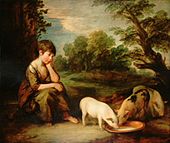
Gainsborough was noted for the speed with which he applied paint, and he worked more from observations of nature (and of human nature) than from application of formal academic rules. The poetic sensibility of his paintings caused Constable to say, "On looking at them, we find tears in our eyes and know not what brings them." Gainsborough said, "I'm sick of portraits, and wish very much to take my viol-da-gam and walk off to some sweet village, where I can paint landskips (sic) and enjoy the fag end of life in quietness and ease." His liking for landscapes is shown in the way he merged figures of the portraits with the scenes behind them. His later work was characterised by a light palette and easy, economical strokes.[11]
His most famous works, Portrait of Mrs. Graham; Mary and Margaret: The Painter's Daughters; William Hallett and His Wife Elizabeth, nee Stephen, known as The Morning Walk; and Cottage Girl with Dog and Pitcher, display the unique individuality of his subjects. Joshua Reynolds considered Girl with Pigs ' the best picture he (Gainsborough) ever painted or perhaps ever will'.[10]
Gainsborough's only known assistant was his nephew, Gainsborough Dupont.[3] In the last year of his life he collaborated with John Hoppner in painting a full length portrait of Lady Charlotte Talbot.
In 2011, Gainsborough's portrait of Miss Read (Mrs Frances Villebois) was sold by Michael Pearson, 4th Viscount Cowdray for a record price of £6.5M.[12] She was a matrilineal descendant of Cecily Neville, Duchess of York, and the mitochondrial DNA descent through which the remains of Richard III of England were identified in 2013 passes through her and her daughter Harriet:[13][14]
In TV, fiction and music
- Kitty (1945) is a notable fictional film about Gainsborough, portrayed by Cecil Kellaway.
- In the song "20th Century Man" from the Kinks' 1971 album Muswell Hillbillies, Ray Davies lists Gainsborough as one of the painters he prefers to "your smart modern painters".
- Two potential works by Gainsborough were investigated in the third series of Fake or Fortune?.

Gallery of selected works
-
Lady Lloyd and Her Son, Richard Savage Lloyd, of Hintlesham Hall, Suffolk, 1745
-
Landscape in Suffolk (1748)
-
Mr. and Mrs. Robert Andrews, (c. 1748–1750)
-
The Painter`s Daughters Chasing a Butterfly, (1756)
-
Two Daughters with a Cat (c. 1759)
-
Portrait of the Composer Carl Friedrich Abel with his Viola da Gamba (c. 1765)
-
Isabella, Viscountess Molyneux, later Countess of Sefton
-
John Campbell, 4th Duke of Argyll, 1767
-
Portrait Augustus Earl of Bristol, 3rd Earl of Bristol, (c. 1767/68)
-
River Landscape (undated)
-
The Linley Sisters, (1772)
-
Johann Christian Bach, (1776)
-
Gainsborough`s Daughter Mary (1777)
-
Colonel John Bullock (c. 1780)
-
Lady in Blue (c. 1780)
-
An officer of the 4th Regiment of Foot, (c. 1776-1780)
-
The lawyer Joshua Grigby III,
-
Mrs. Sarah Siddons (1785)
-
Mr and Mrs William Hallett (1785).
-
Cottage Girl with Dog and pitcher (1785)
-
Study of a Lady (1785)
-
James Baillie family (c. 1784)
-
Mrs Richard Brinsley Sheridan, (1787)
- Self-Portraits
-
Self-Portrait (1754)
-
Self-Portrait (1787)
-
Self-Portrait (1787)
References
- ^ Fulcher, George William, Life of Thomas Gainsborough , London 1856
- ^ Jackson, William The Four Ages including essays on various subjects Cadell & Davies, London 1798
- ^ a b c d e "Thomas Gainsborough". National Gallery of Art. Retrieved 10 December 2011.
- ^ Conrad, Stephen, ‘Thomas Gainsborough's First Self-portrait’, in The British Art Journal, Vol. XII, No. 1, Summer 2011, pp. 52-59
- ^ Greenwood, Charles (1977). Famous houses of the West Country. Bath: Kingsmead Press. pp. 84–86. ISBN 978-0-901571-87-8.
- ^ Plaque #2 on Open Plaques
- ^ "Thomas Gainsborough Blue Plaque". openplaques.org. Retrieved 13 May 2013.
- ^ Woodall, Mary , Introduction to The Letters of Thomas Gainborough, Cupid Press , London, 1963
- ^ "Restoration of Thomas Gainsborough's tomb". Richmond Guardian. London. 7 March 2011. Retrieved 1 December 2011.
- ^ a b Willes, F.W. Letters of Joshua Reynolds , Cambridge University Press, Cambridge 1929
- ^ Birmingham Museum of Art (2010). Birmingham Museum of Art: A Guide to the Collection. London: Giles. p. 80. ISBN 978-1-904832-77-5. Retrieved 24 June 2011.
- ^ Hardman, Robert (17 July 2011). "Why I'm swapping my £25m house for a cottage". Daily Mail. London.
- ^ http://www.le.ac.uk/richardiii/science/familytree.html
- ^ Turi E. King; et al. (2014). "Figure 1: Genealogical links between Richard III and modern-day relatives who participated in this study". Nature Communications. doi:10.1038/ncomms6631. Retrieved 2 December 2014.
{{cite web}}: Explicit use of et al. in:|author=(help)
Further reading
- Thomas Gainsborough, William T. Whitley, (John Murray, 1915) - the most respected biography
- Gainsborough, Ellis Waterhouse, (Edward Hulton, 1958) - the standard catalogue of the portraits etc.
- The Letters of Thomas Gainborough, ed. Mary Woodall, (Cupid Press, 1963)
- The Drawings of Thomas Gainsborough, John Hayes, (Two volumes, Zwemmer, 1970) - the standard catalogue of the drawings
- Gainsborough as Printmaker, John Hayes, (Zwemmer, 1971) - the standard catalogue of the prints
- Gainsborough, John Hayes, (Phaidon, 1975)
- Gainsborough & Reynolds in the British Museum, ed. Timothy Clifford, Antony Grffiths and Martin Royalton-Kisch, (BMP, 1978)
- Thomas Gainborough, John Hayes, (Tate Gallery, 1981)
- The Landscape Paintings of Thomas Gainsborough, John Hayes (Two volumes, Sotheby's, 1982) - the standard catalogue on the landscape paintings
- Thomas Gainsborough: His Life and Art, Jack Lindsay, (Harper Collins, 1982)
- A Nest of Nightingales: Thomas Gainsborough, The Linley Sisters. Paintings and their Context II, ed. Giles Waterfield, (Dulwich PIcture Gallery, 1988)
- The Paintings of Thomas Gainborough, Malcolm Cormack, (Cambridge University Press, 1991)
- Gainsborough & Reynolds: Contrasts in Royal Patronage, exhibition catalogue, (Queen's Gallery, 1994)
- Gainsborough's Vision, Amal Asfour and Paul Williamson (Liverpool University Press, 1999)
- The Art of Thomas Gainborough: A little business for the Eye, Michael Rosenthal, (Yale University Press, 1999)
- The Letters of Thomas Gainsborough, ed. John Hayes (Yale University Press, 2001)
- Thomas Gainsborough’s 'Lost' Portrait of Auguste Vestri, Martin Postle, Tate Online Research Journal, http://www.tate.org.uk/download/file/fid/7407
- Gainsborough, eds. Michael Rosenthal and Martin Myrone, (Tate, 2002)
- Gainsborough in Bath, Susan Sloman, (Yale University Press, 2002)
- Gainsborough, William Vaughan, (World of Art, Thames & Hudson, 2002) - the most accessible introduction
- Sensation & Sensibility: Viewing Gainsborough's Cottage Door, ed. Ann Bermingham (Yale University Press, 2005)
- 'Tom Will Be A Genius' New Landscapes by the Young Thomas Gainsborough, Diane Perkins, Lindsay Stainton & Bendor Grosvenor, (Philip Mould, 2009), http://www.philipmould.com/docs/gainsborough/index.html#/1/zoomed
- Thomas Gainsborough's First Self-portrait, Stephen Conrad, in The British Art Journal, Vol. XII, No. 1, Summer 2011, pp. 52-59
- Thomas Gainsborough and the Modern Woman, ed. Benedict Leca, (Giles, 2011)
- Gainsborough's Landscapes: Themes and Variations, Susan Sloman, (Philip Wilson, 2012)
- Rossetti, William Michael (1911). . In Chisholm, Hugh (ed.). Encyclopædia Britannica. Vol. 11 (11th ed.). Cambridge University Press.
- Monkhouse, William Cosmo (1889). . In Stephen, Leslie (ed.). Dictionary of National Biography. Vol. 20. London: Smith, Elder & Co.
- Belsey, Hugh. "Gainsborough, Thomas (1727–1788)". Oxford Dictionary of National Biography (online ed.). Oxford University Press. doi:10.1093/ref:odnb/10282. (Subscription or UK public library membership required.)
External links
- 371 Artworks by or after Thomas Gainsborough at the Art UK site
- Webmuseum Paris: Thomas Gainsborough
- Victoria and Albert Museum collection
- http://www.abcgallery.com/G/gainsborough/gainsborough.html Olga's Gallery
- www.gac.culture.gov.uk/search/Artist.asp?maker_id=112361
- www.Thomas-Gainsborough.org 70 works by Thomas Gainsborough
- Thomas Gainsborough exhibition catalogs
See also
- Gainsborough's House
- English art
- Art of the United Kingdom
- List of British painters
- Humphrey Gainsborough
- Holywells Park, Ipswich
- Western painting
- Use dmy dates from February 2012
- 1727 births
- 1788 deaths
- People from Sudbury, Suffolk
- Burials at St. Anne's Church, Kew
- 18th-century English painters
- Royal Academicians
- English portrait painters
- Landscape artists
- Rococo painters
- People associated with the Royal Society of Arts
- Cancer deaths in England
- People educated at Sudbury Grammar School







